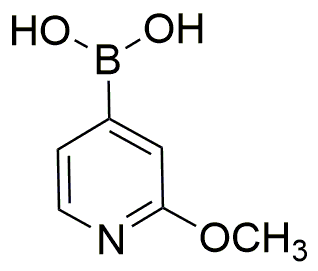2-Methoxypyridine-4-boronic acid is widely utilized in research focused on:
- Pharmaceutical Development: This compound serves as a crucial building block in the synthesis of various pharmaceuticals, particularly in the development of drugs targeting cancer and other diseases, due to its ability to form stable complexes with biologically relevant molecules.
- Organic Synthesis: It is employed in cross-coupling reactions, such as Suzuki-Miyaura coupling, which allows chemists to create complex organic molecules efficiently, making it invaluable in the production of agrochemicals and fine chemicals.
- Material Science: The compound is used in the preparation of advanced materials, including polymers and nanomaterials, which have applications in electronics and coatings, enhancing performance characteristics like conductivity and durability.
- Bioconjugation: Its boronic acid functionality enables the selective labeling of biomolecules, facilitating the study of protein interactions and cellular processes, which is essential in biochemistry and molecular biology research.
- Environmental Chemistry: It can be utilized in the development of sensors for detecting pollutants, offering a practical solution for monitoring environmental health and safety, thus contributing to sustainable practices.
General Information
Properties
Safety and Regulations
Applications
2-Methoxypyridine-4-boronic acid is widely utilized in research focused on:
- Pharmaceutical Development: This compound serves as a crucial building block in the synthesis of various pharmaceuticals, particularly in the development of drugs targeting cancer and other diseases, due to its ability to form stable complexes with biologically relevant molecules.
- Organic Synthesis: It is employed in cross-coupling reactions, such as Suzuki-Miyaura coupling, which allows chemists to create complex organic molecules efficiently, making it invaluable in the production of agrochemicals and fine chemicals.
- Material Science: The compound is used in the preparation of advanced materials, including polymers and nanomaterials, which have applications in electronics and coatings, enhancing performance characteristics like conductivity and durability.
- Bioconjugation: Its boronic acid functionality enables the selective labeling of biomolecules, facilitating the study of protein interactions and cellular processes, which is essential in biochemistry and molecular biology research.
- Environmental Chemistry: It can be utilized in the development of sensors for detecting pollutants, offering a practical solution for monitoring environmental health and safety, thus contributing to sustainable practices.
Documents
Safety Data Sheets (SDS)
The SDS provides comprehensive safety information on handling, storage, and disposal of the product.
Product Specification (PS)
The PS provides a comprehensive breakdown of the product’s properties, including chemical composition, physical state, purity, and storage requirements. It also details acceptable quality ranges and the product's intended applications.
Certificates of Analysis (COA)
Search for Certificates of Analysis (COA) by entering the products Lot Number. Lot and Batch Numbers can be found on a product’s label following the words ‘Lot’ or ‘Batch’.
Número de catálogo
Número de lote/lote
Certificates Of Origin (COO)
This COO confirms the country where the product was manufactured, and also details the materials and components used in it and whether it is derived from natural, synthetic, or other specific sources. This certificate may be required for customs, trade, and regulatory compliance.
Número de catálogo
Número de lote/lote
Safety Data Sheets (SDS)
The SDS provides comprehensive safety information on handling, storage, and disposal of the product.
DownloadProduct Specification (PS)
The PS provides a comprehensive breakdown of the product’s properties, including chemical composition, physical state, purity, and storage requirements. It also details acceptable quality ranges and the product's intended applications.
DownloadCertificates of Analysis (COA)
Search for Certificates of Analysis (COA) by entering the products Lot Number. Lot and Batch Numbers can be found on a product’s label following the words ‘Lot’ or ‘Batch’.
Número de catálogo
Número de lote/lote
Certificates Of Origin (COO)
This COO confirms the country where the product was manufactured, and also details the materials and components used in it and whether it is derived from natural, synthetic, or other specific sources. This certificate may be required for customs, trade, and regulatory compliance.


